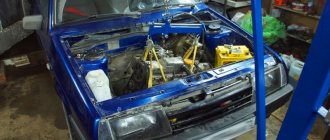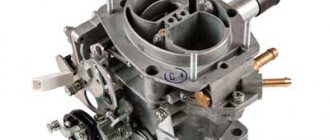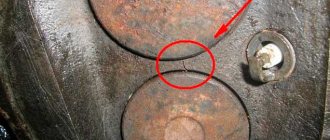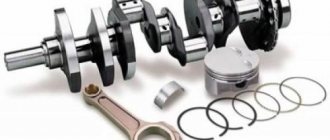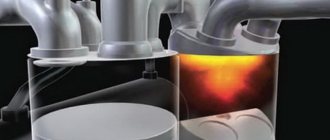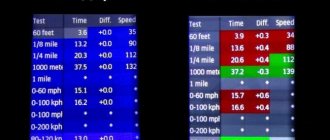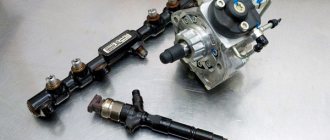Signs of loss of engine power
Operating the engine under difficult conditions and poor fuel quality can lead to a decrease in engine power.
This article provides a list of the main faults that affect the power of a car engine. If the time required to accelerate a car increases by more than 25 percent, and the optimal speed decreases by 15 percent or more, this is a clear sign. The drop in engine power is clearly felt when the car moves uphill.
Here is a list of the main signs of a drop in engine power:
- the car does not respond properly to pressing the gas pedal, there are delays of several seconds;
- the engine speed suddenly decreases for no apparent reason;
- After pressing the gas accelerator, jerks occur in the movement of the car.
Loss of power and engine response, reasons related to the ignition system
The car doesn't drive and doesn't pull well.
It seems that someone is holding it from behind, you press the gas all the way to the floor, and the engine response is sluggish, or the engine stalls altogether after pressing the gas pedal. Similar statements are typical of many motorists who are faced with a drop in power and throttle response of a car engine. There can be many reasons for this malfunction (carburetor, power system, engine itself, etc.). In this article we will look at the reasons for the drop in power and throttle response of a carburetor car engine associated with the ignition system.
Almost always, most car repairmen recommend first fixing problems with the ignition system, and then getting into the carburetor and other systems. As an example for troubleshooting, let's take the carburetor engines of front-wheel drive VAZ 2108, 2109, 21099 cars with a contactless ignition system.
The main reasons for the drop in power and throttle response of the carburetor engine of VAZ 2108, 2109, 21099 cars associated with the ignition system
— The ignition timing is set incorrectly
If the ignition is too early, the engine will pick up well at the low end, but as it accelerates, the car's dynamics will deteriorate sharply. Detonation will be heard (“fingers knock”) when you press the gas pedal.
Ignition too late, on the contrary, reduces throttle response at low speeds and during acceleration, and at medium and heavy loads the car can drive more or less acceptable. Here the problem is mitigated by a rich fuel mixture and the entry into operation of the vacuum and centrifugal ignition timing regulators, making the timing earlier.
The ignition timing must be checked and set correctly first (See “Setting the ignition timing on engines of VAZ 2108, 2109, 21099”). Initially, it can be corrected by rotating the distributor relative to the scale: to the left - earlier ignition, to the right - later.
Adjusting the ignition timing by rotating the distributor on VAZ 21083, 21093, 21099
— Sticking weights or loosening of the springs of the centrifugal advance regulator in the distributor
The centrifugal regulator makes ignition earlier as engine speed increases due to the divergence of weights held by springs. If the weights get stuck or the springs break, the advance angle will remain the same, but the car engine needs earlier angles to gain power and throttle response. Accordingly, one cannot expect any improvement in dynamics from the car.
To fix the problem, you will have to remove the distributor, remove the centrifugal regulator and replace the weights and springs with new ones. In some cases, you can get by with simply cleaning the parts. See “Centrifugal ignition timing regulator for VAZ 2108, 2109, 21099”.
Operation of the centrifugal ignition timing regulator for VAZ 2108, 2109, 21099 cars
— The vacuum supply tube to the vacuum ignition timing regulator in the distributor has come off or is not sealed
The vacuum ignition timing regulator also makes the ignition slightly earlier at power levels in order to increase the efficiency of the engine. For example, if a car pulls poorly on a hill, then one of the most likely causes will be a failure of the vacuum regulator.
The design of the vacuum regulator must be completely sealed (housing, tube). Therefore, first of all, we check the vacuum supply tube, the tightness of its fit on the carburetor fitting and on the fitting of the vacuum regulator housing on the distributor. If the diaphragm in the regulator body is broken, it must be replaced with a new one. We also remove the distributor cover and the protective screen and check the fastening and clear movement of the regulator rod. For more details, see “Vacuum ignition timing regulator for VAZ 2108, 2109, 21099”.
Vacuum ignition timing regulator for VAZ 2108, 2109, 21099 cars
— Spark plugs are faulty
Most often, faulty spark plugs give themselves away by popping noises in the muffler and unstable operation of the car engine at idle. We check the spark plugs for carbon deposits on the electrodes, the condition of the electrodes themselves, and the gap between them. A working candle has a brown soot (different shades are possible). A faulty one will most often have black carbon deposits or be oily.
In addition, by starting the engine in the dark and detecting a glow on the spark plug body, you can check for a “breakdown” of the spark plug insulator. You should also pay attention to the suitability of the spark plugs for the given engine (See “Applicability of spark plugs on VAZ car engines”). If during the inspection it is not possible to identify a malfunction, then instead of the old spark plugs we install a set of new ones.
Black carbon deposits on spark plugs
— High-voltage wires are “broken”
The influence of high-voltage wires on engine operation in power modes is enormous, since the failure of at least one of them disables one cylinder. And then what kind of power and throttle response can we even talk about? Faulty high-voltage wires (armored wires) most often manifest themselves as unstable engine idling and misfires (popping noises in the muffler). Not always true. Therefore, it is best to check them with a tester (See “Checking high-voltage wires”). But first of all, of course, their visual inspection is necessary (contamination, presence of cracks, condition of contacts and protective tips) and a “breakdown” test by starting the engine in the dark and checking the glow on the wires.
Checking the central core of the high-voltage wire
— The switch is faulty
Complete failure of the switch will make it impossible to start the engine. In case of loss of power and throttle response of the engine of VAZ 2108, 2109, 21099 cars, we are talking about its incorrect operation. In such a situation, only replacing the switch with a known good one can clear up the situation. You can roughly estimate whether the switch is working or not using the voltmeter readings (“Checking the switch of VAZ 2108, 2109, 21099 cars”).
Ignition system switch for VAZ 2108, 2109, 21099 cars
Notes and additions
— The drop in power and throttle response of a car engine is also affected by: “broken” ignition coil cover, slider, distributor cover, Hall sensor. But these malfunctions are manifested, in addition to everything, by unstable operation of the engine until it stops, problems with starting, which is not always the case for the main reasons listed above.
— Besides everything, it’s worth checking the support plate in the distributor: its condition (integrity), fastening, presence of contamination. For more details, see “Faults in the distributor of VAZ 2108, 2109, 21099 cars.”
Twokarburators VK - More information on the topic in our VKontakte group, on Facebook Twokarburators FS and on Odnoklassniki - Twokarburators OK
More articles on the ignition system of VAZ 2108, 2109, 21099 cars
— Features of installing the ignition coil on VAZ 2108, 2109, 21099 cars
— Diagram of the ignition system for VAZ 2108, 2109, 21099 cars
— NGK spark plugs for engines of VAZ 2108, 2109, 21099 cars
— Unstable idle speed of the engine of VAZ 2108, 2109, 21099, reasons related to the ignition system
— Malfunctions of the contactless ignition system of VAZ 2108, 2109, 21099 cars
— The engine does not pull, why and what to do?
Eliminating the causes of reduced engine power
To eliminate the causes of a drop in engine power, it is necessary to conduct effective engine diagnostics. As a rule (if the engine is not new), one of the reasons is the formation of carbon deposits on the working surfaces of the engine.
We offer a unique service for washing engines at a special professional stand. The service includes flushing the fuel system and flushing the engine from carbon deposits. Special equipment allows you to supply flushing mixtures to the engine in doses according to a specific schedule. This technology allows you to effectively clean the fuel system, clean the engine of carbon deposits and safely remove coke and carbon deposits through the exhaust system.
Professional engine flushing provides:
- increase in real engine power;
- stable engine operation;
- reduction of gasoline consumption;
- increased acceleration dynamics;
- reduction in engine operating temperature;
- reducing wear of parts and mechanisms.
Professional engine flushing at a stand allows you to eliminate a number of reasons for a drop in engine power, significantly increase engine power and reduce fuel consumption.
2) Problems with fuel supply, injection and ignition
An engine runs best when air and fuel are properly mixed and burned without leaving any residue in the combustion chamber. To effectively complete this process, a number of fuel and ignition system components must work together like clockwork.
While there are many moving parts that help an engine run smoothly, improper fuel delivery, fuel injection and misfires are some of the biggest problems in vehicle operation. To reduce misfires or correct fuel injection problems, check the fuel system and ignition for proper performance.



